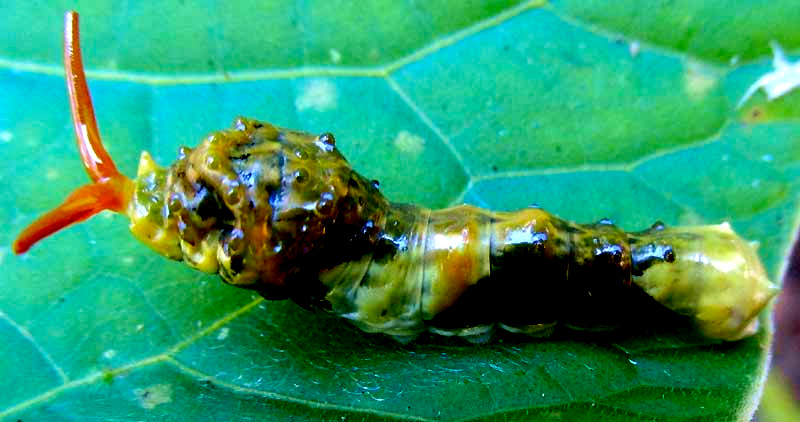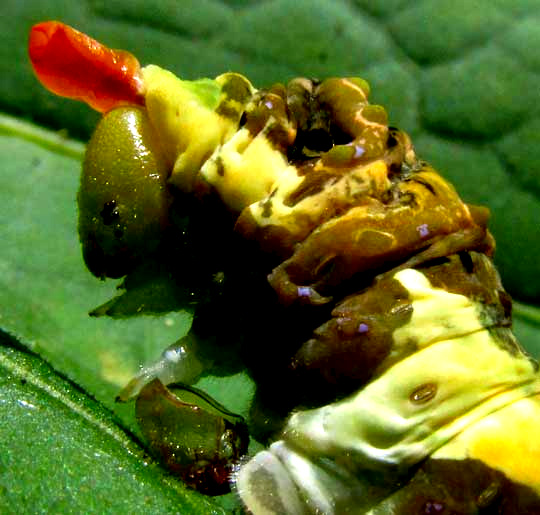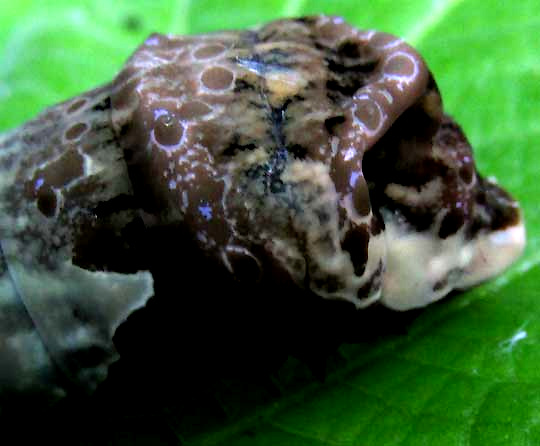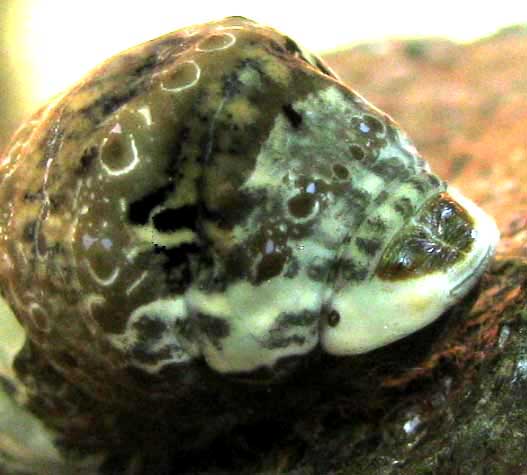Excerpts from Jim Conrad's
Naturalist Newsletter

from the December 27, 2015 Newsletter issued from Hacienda Chichen Resort beside Chichén Itzá Ruins, central Yucatán, MÉXICO
"BLACK-PEPPER DOG"
Soon after my return to Hacienda Chichen, next to the hut I planted a small tree, in Spanish called Hoja Santa, an important member of the tropical Black Pepper Family, the Piperaceae. Our Hoja Santa Page is at www.backyardnature.net/mexnat/piper-au.htm.
One morning I was checking on it when a bird dropping turned up on one of the Hoja Santa's big, fragrant leaves. But then the dropping moved. As I stooped and bent for a very close look, in a flash two orange "antennae" materialized atop the poop's bigger end. The whole thing is shown above.
This was an exciting find, for this one displayed "osmeteria." Osmeteria are orange or reddish, Y-shaped, eversible glands located just behind the head. When attacked by small predators such as ants or spiders,the caterpillar extrudes the gland so that it looks like an orange or reddish antler, and tries to wipe it against the attacker. The osmeteria of older caterpillars contain a highly noxious, pungent chemical that smells like rancid butter."
We've seen osmeteria on the caterpillar of a closely related Black Swallowtail, which you can see down the page at www.backyardnature.net/n/a/b-s-cat.htm.
For several days I visited our Hoja Santa caterpillar regularly, sometimes accompanied by tourists on my free walks, the poor Hoja Santa always displaying a few more holes in its leaves. Then one day the caterpillar turned up looking as is shown below:

He was bigger, bumpier, more brightly colored, and that white, crumpled, cellophane-like thing was sticking to his rear end. Well, not only do butterfly caterpillars metamorphose into pupa, which metamorphose into adult butterflies, but also caterpillars go through spurts of growth, each time shedding their old "skins." Each ever-larger stage between shedded skins is known as an instar. Clearly, our little friend had just grown into a newer, bigger instar. And he didn't seem to be comfortable with the idea. From time to time he'd jerk violently, and didn't move at all for the rest of the day. However, he still could stick out his osmeteria, at least slightly, as shown below:

In that picture, notice the brownish, semitransparent item below the head. That's the old covering of his compound eyes. Notice that the old covering is smaller than the compound eyes he has now. A closer look at this is given below:

As of this writing the caterpillar still is there, over a week after first turning up, and now he's entered yet another instar, becoming darker and grayer, more ridged and wrinkled, and developing some extraordinary bluish hues only noticeable up close, as shown beflow:

So, our caterpillar has really put on a show for us, but was he really an Orange Dog? In reviewing our Orange Dog Page I was reminded that there are two closely related swallowtail species in our area producing very similar caterpillars, of which one was our earlier identified Orange Dog. Back then I also wrote, "...an expert Bea double-checked with in the US thinks that Thoas butterfly caterpillars probably feed on members of the Black Pepper Family, the Piperaceae, while Giant Swallowtail caterpillars feed on citrus... "
So, there you go. In 2011 we saw the Orange Dog larva of the Giant Swallowtail butterfly, exactly where he should have been, on an Orange Tree, which is a member of the Citrus Family. Now in 2015 we've seen the larva of the Thoas Swallowtail, PAPILIO THOAS, exactly where he belongs, on a member of the Black Pepper Family.
It's wonderful when things fall together like this.
By the way, the "Black Pepper-Dog" name is one I made up. This Black-Pepper-Family-loving species doesn't occur up north in English-speaking territory so it has no English name. The name is just being consistent with the other name, Orange Dog, which is well established in Orange-tree-growing Florida.
from the April 17, 2011 Newsletter issued from Hacienda Chichen Resort beside Chichén Itzá Ruins, central Yucatán, MÉXICO; limestone bedrock, elevation ~39m (~128ft), ~N20.676°, ~W88.569°
DOUBLE-WHAMMY CATERPILLAR

Next to the septic-tank hole I'm digging with a shovel each morning for an hour or so, for exercise, stands an orange tree. One morning this week, on a stem of the orange I noticed the amazing caterpillar shown above. The caterpillar, about two inches long (5cm), is remarkable because not only is it well camouflaged as a fresh dropping of bird poop, but also its front end looks like a reptilian or amphibian head, better shown below:

To me the head looks like it belongs to a gecko or other kind of lizard, but others say it's a snake's head. Whoever the head looks like, the fake eyes, nostrils and wide mouth could be disconcerting to any predator approaching from the side or front.
Naturally I sent photos of the caterpillar to Bea in Ontario, who immediately recognized it as a member of the Swallowtail Family, the Papilionidae. Starting with that, it wasn't long before she knew we had one of two species: Either it was the caterpillar of the Giant swallowtail, Papilio antimachus, or else of the very similar Thoas Swallowtail, Papilio thoas. Since we've identified Thoas Swallowtails here and not Giants, we figured that the caterpillar is that of the Thoas Swallowtail.
When I took the above pictures I didn't know one of the most fascinating facts about this caterpillar. That is, in addition to looking like bird poop and a lizard's head, each larva possesses an "osmeterium," which is an orange or reddish, Y-shaped, eversible gland located just behind the head. When attacked by small predators such as ants or spiders the caterpillar extrudes the gland so that it looks like an orange or reddish antler, and tries to wipe it against the attacker. The osmeteria of older caterpillars contain a highly noxious, pungent chemical that smells like rancid butter.
The day after I took the above pictures I returned to the tree hoping to antagonize the caterpillar into extending osmeterium, but he was gone, or least better hidden than when I'd earlier found it. But you can bet that the next one I see I'll try to see that osmeterium.